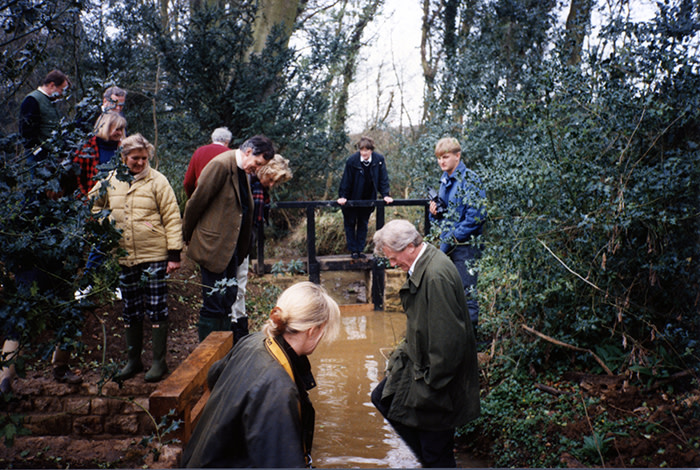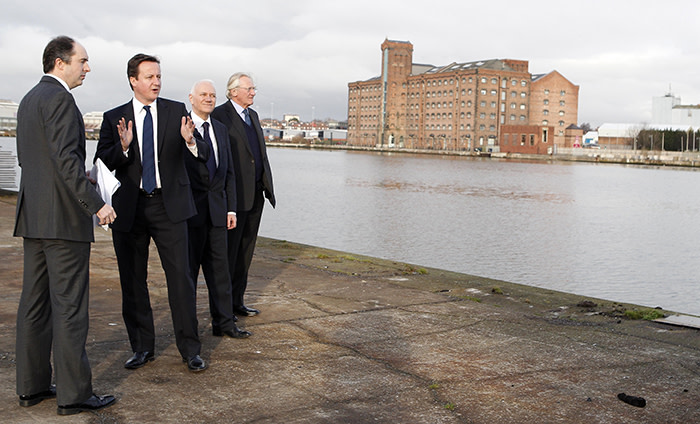Michael Heseltine: how green spaces transform inner cities
Simply sign up to the Life & Arts myFT Digest -- delivered directly to your inbox.

Sitting in the warm looking out at the tits dashing on and off the bird table against a background of hard frost and clear blue sky I realise how little has changed over my lifetime. In the background, the trees and shrubs reveal the fascination of their skeleton shapes, and a defiant Hamamelis foretells the spring that is to come. I must not forget the snowdrops. Our collection numbers more than 500 named varieties. Some think it’s madness, as they stick their stamps in carefully prepared albums! I was captivated by the same thoughts, reactions and emotions as a gardener and birdwatcher when as a child in the 1940s I helped my grandfather attack daisies destroying his lawn and my parents regain control over the two-acre garden they purchased after the war ended. I became a proud owner of a garden for the first time around that time.
A farsighted headmaster, Kenneth Thompson, gave every new boy at his school, Broughton Hall in Staffordshire, a square yard of mud and a packet of Virginia stock seeds. Six weeks later I had a square yard of dazzling colour and I have never looked back. The scale may be bigger — my wife and I have created a 70-acre arboretum with more than 4,000 different types of trees and shrubs here at Thenford in Northamptonshire — but the enjoyment, the sense of achievement, the pride of creativity are just as they were.
Two things, however, have not so much changed as emerged in a way that could not have been anticipated. First, I have learnt something of the gardening community — the sheer scale of it, its historic significance and the remarkable contribution to be found within it for human contentment and achievement. Second, I would not have begun to understand how, in decade after decade at the frontline of national politics in one government department after another, improving the environment, rebuilding and reclaiming derelict land — and thus helping the horticultural industry — would run as a theme through so many political initiatives.

First, in the Ministry of Transport, shortly to become the newly created Department for the Environment, I helped to define proposed boundaries for the new conurbation authorities. Suburban and rural areas fought to protect their environment and remain outside the perceived menace of the city. My proposal to recognise Wilmslow as a part of Greater Manchester almost certainly secured my move to Minister of Aerospace and Shipping. The launch of Concorde and the rescue of Rolls-Royce were far removed from any horticultural connection. However, establishing the European Space Agency led to this country securing a technological lead in satellite technology. And here at Thenford a satellite system is enabling us to pinpoint to the nearest square metre each tree, shrub and bulb and the next step will lead to photographic recognition on a handheld device. All in a night’s work in Brussels!
In 1979 Margaret Thatcher invited me to be secretary of state for the Environment. My first target was 6,000 derelict acres of London’s Docklands and the banks of the Mersey in Liverpool. The latter was an ideal site for another policy initiative — garden festivals. Philip Goodhart, MP for Beckenham, told me of widespread practice in war-torn Europe to restore bombed sites by first greening them and thus making them attractive to developers. Liverpool’s 600 acres of derelict land were perfect for the purpose. There was some initial scepticism: “Give us jobs, not trees”, someone shouted in 1981 but the International Garden Festival’s remarkable achievement in attracting 3m visitors in 1984 played a part in the city’s recovery. The regeneration model was repeated in Stoke, Ebbw Vale, Glasgow and Gateshead. I remain to this day sad that there the concept died. The development corporation concept has, however, survived in England and Wales. It centred decision-making under one board with the resources to implement them. It encouraged strategic thinking across a wide area in place of the site-by-site approach upon which most planning decisions depend.
Liverpool in 1979 was the test-bed for another policy initiative that is now widespread practice — competitive bidding and gearing. In the 1970s, grants were made available to restore coal tips, those eyesores created by ore extraction and quarry waste. By 1979, the grants had largely done their work and I saw the opportunity to use the budget to restore urban sites for housing with one condition: grant aid depended on a housebuilder agreeing to build housing. As a consequence, every pound of grant money secured additional private sector funding. It was a genuine win-win change in public policy that I was to revisit in many different forms over the years.


It is widely believed that the riots in Liverpool in 1981 — the Toxteth Riots between the local police and the black community that followed similar riots in Brixton, London, earlier that year — led to the changes I have described. The reverse is the truth. Two years earlier, in 1979, I listed the Albert Docks, announced the Development Corporation, the Garden Festival and the housing initiatives described earlier. It was precisely because I had become so involved that I felt a personal responsibility when the riots took place two years later.
However, there were two initiatives that grew out of the three weeks I spent walking the streets of Liverpool that summer of 1981 following the riots. One of the places I visited was Cantril Farm, a run-down council estate in Knowsley, a village near Liverpool. Its occupancy was in the low 30 per cent and the council was in despair. I persuaded Barclays Bank and the Abbey National bank to take over and put in an effective management team led by Tom Barron. Today, Stockbridge Village Trust, a not-for-profit housing association in Knowsley, is a model of public private housing in a flourishing community. The model was eventually to lead to City Challenge in the 1990s. The early task was to reclaim derelict land.
We now turn to the infinitely more complex problem of helping deprived communities. Hulme estate in Manchester was a rat-infested slum described as one of the worst estates in Europe. Today, it is a flourishing extension of the city centre. An essential feature of the transformation was not just public-private partnership but the involvement of the tenants themselves in the transformation. Around that time, with the housing minister Sir George Young, we began the process of empowering council tenants in the management of their estates.

The second initiative led to the foundation of Groundwork. The idea that was put to me was centred on the urban fringe, that dumping ground for the detritus of human indifference on the edge of too many communities. The rags, paper, cardboard and wooden rubbish, the abandoned prams, the discarded tyre, the blocked-up stream, what could so easily be an attractive green environment became peripheral dumping grounds. I supported the birth of Groundwork as it planned to create groups of volunteers to clean up their backyard, starting in St Helens. Today, Groundwork helps 2,700 projects in the UK and supports 4,700 charities.
Leaving government in 1997 could so easily have ended my involvement in environmental initiatives. John Major, however, had invited me to be a Millennium Commissioner with a Lottery-funded billion-pound-plus budget. The Eden Project met the commission’s determination to create the highest quality environmental schemes with economic stimulus for that part of England and added to Eden co-founder Tim Smit’s reputation for restoring the Lost Gardens of Heligan, which my wife and I had visited.
Even that was not to be the end of the story. David Cameron and his colleagues invited my participation in a growing range of projects. Two of these have a particular relevance to the environment and thus the horticultural industry that is inseparable from it. The then chancellor George Osborne agreed that I should look at the potential to extend the regeneration of London Docklands into an area of economic activity that ended close to the sea at Southend and Canterbury.


Once you pass the London boroughs the challenges are not about rebuilding communities and regenerating yesterday’s land use. Most of the area is rural interspersed with relatively prosperous self-sustaining communities. Over the next 20 or30 years there will be very large increases in population in this area. The question is whether the demand is met by urban sprawl or whether the government is prepared to adopt a visionary plan for new or expanded communities with proper communications built within attractive environments. Is there the vision to create the great parks of our century, the environmental sanctuaries and the centres of excellence that modern economies increasingly need or will the “nimby” instinct to fight every development simply mean the politicians will opt for the easier, less-perceived process of just letting it happen field by field?
In 2015, the then Prime Minister David Cameron asked me to become involved in his project to bring a new perspective to the hundred most deprived estates. There are two ways to approach such a task. The first is to start with the property components, publicly and privately owned homes, unused land, height and density of building to give higher-density housing in an improved environment. That is important and capable of delivering significant benefit. There are few obstacles to progress if the will is there but the one problem that confronts you at every turn is a blocker. There is no one in charge. There are numerous budgets, different quangos, land is spread across the public and private sector and the planning system is a law unto itself. The housing crisis itself, let alone the deprivation of selected estates, requires an overlord and it needs such a person now.
There is, however, another approach that should be pursued at the same time. Start with the people. A few years ago I asked Albert Bore, the then leader of Birmingham city council, if he would select one of his more deprived estates and arrange a meeting of the people who were directly responsible for administering public funds in support of specific identified problems particularly associated with such estates. The meeting took place. Well-meaning and motivated people gathered together. Social workers, police, drug experts, mental health specialists, unemployment specialists with one thing in common — they had never met. This reflects a serious deficiency in UK central government structure.


Horticulture is sponsored by Defra. The Home Office deals with drugs and crime. The Health Department, mental health. Department for Communities and Local Government with local government, and the Department for Employment with unemployment. There are two gaps. Insufficient attention will focus on the place-based challenge of living in a deprived community in the first place. Second, little attempt will be made to involve the local people themselves. It follows that if there is no attempt to look at the issues at large there will be no attempt to create a total budget that indicates the cost of supporting such deprived communities. If there is no budget you cannot consult the beneficiaries of this expenditure as to its effectiveness.
That is where you will find the truly forgotten people of our time. The challenges of such concentrated deprivation — unemployment, lack of skills, low education attainment, obesity, loneliness and mental health issues — all focus on the question, “How do you help people feel a sense of purpose, an interest in what their life holds?”. There are no simple answers to complex questions but gardening can play a part. Michael Gove, the current secretary of state for the environment, is a minister who thinks outside the box. He should encourage his colleagues to experiment. Derelict land is all too present. Provide local people with the tools to plant it. If they plant it they may feel a pride in what they did. They may wish to defend it, even extend it. The work requires little skill but it offers ladders. If a person starts by tidying the garden of a poor, elderly, neighbouring pensioner, there is a short journey to a full-time job with elderly people willing to pay someone to do the same in nearby more prosperous suburbs. Mental health is often associated with the condition of people living in deprived communities. It is a serious problem with many causes. It can be a consequence of joblessness or financial poverty. Giving people a purpose in life may counter the pressures they feel.
In all our deprived communities there are dedicated people doing their best with large sums of public money. What is missing is a coherent people-centric and co-ordinated sense of purpose.

Michael Heseltine is a former British deputy prime minister
‘Lord Heseltine: My Vision for GreenerCities’ will feature the author in conversation with Evan Davis at the Garden Museum, London, on March 6 2018
Follow @FTProperty on Twitter to find out about our latest stories first. Subscribe to FT Life on YouTube for the latest FT Weekend videos
Comments